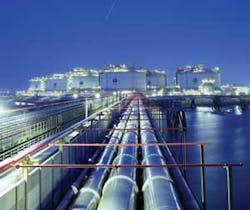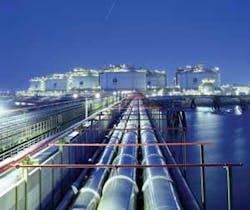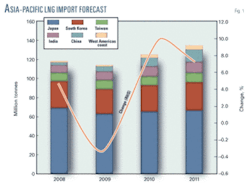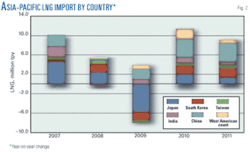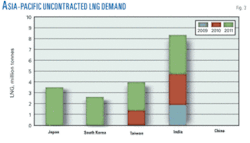Asian LNG demand growth has been critical in the growth of global LNG, accounting for an average 50% of global incremental consumption since 2000. In 2008, incremental demand growth in Asia was substantially higher than in other regions, as imports of key consumers such as Japan and Korea pushed up regional growth.
Europe’s marginal consumption growth coupled with Asia helped offset a massive decline in LNG imports into the Americas, specifically the US. While global LNG demand has grown by an average 8%/year since 2000, preliminary estimates for 2008 indicate essentially no growth. This was partly due to project delays and will certainly change this year as new projects push LNG into the market.
There are questions, however, about just how much LNG the market can absorb. Significant uncertainty surrounds prospects for the next few years as the depth of the current global financial crisis has yet fully to reveal itself.
Given that the Asian market has not only driven incremental demand growth in recent years, but has also accounted for about two thirds of the global LNG market, it is important to understand growth prospects for the region, as they will have implications for the global LNG market.
This article will look at demand among Asian LNG importers over the next few years.
It must be noted that while the term LNG “demand” is commonly used, it is a bit of a misnomer. A more accurate term would be “likely imports.” Even if an economy slows or contracts sharply (as we expect to see in 2009), LNG imports can increase with the delivery of new contracted volumes.
Of course, this does not necessarily indicate strong demand but rather a supply push. This would likely be accompanied by price weakness and reduced demand for spot cargoes. For the purpose of this piece, we stick with convention and refer to “demand.”
Economies suffer
The global economy has slowed significantly over the past 6-8 months. The US financial crisis was the initial trigger, but the impact soon spread to other geographic regions and economic sectors.
Originally, Asia appeared to weather the crisis. Most monetary authorities had accumulated substantial foreign reserves and regional banks were typically well capitalized. Regulatory oversight had also improved following the 1997-98 Asian economic crises. Some briefly speculated (or hoped) that Asian economies had largely “delinked” from the US and Europe and would come through the crisis relatively unscathed.
The past few months, however, have made clear that talk of such a delinkage from the global economy was misguided. October-November 2008 economic data showed clear signs of slowdown. Meanwhile, key indicators of energy use are off sharply.
After averaging some 14%/year growth since 2002, Chinese power demand was down by 3% year-on-year (y-o-y) in October 2008 and 8% in November 2008. Auto sales also slowed sharply in both China and India. The impact of lethargic global and regional trade on highly export-dependent economies, such as Singapore, Taiwan, and Hong Kong, has become readily apparent and will affect demand for the power sector as well as industrial use.
New markets
In spite of the recent economic turmoil, the Asia-Pacific LNG market will remain relatively robust beyond 2009. Fig. 1 shows our base-case scenario.
While imports in 2008 increased by an estimated 4.7% from 2007 levels, they will contract slightly in 2009. This reduction in demand, however, will be tempered by relatively strong growth in China and, to a lesser extent, India.
Fig. 2 illustrates the region’s incremental imports by country through 2011. The majority of incremental demand growth will come from such new markets as China and India, while the more mature markets of Japan, Korea, and Taiwan will experience slower growth in 2010-11. Several factors are at play here for each country that is examined.
Japan
In 2008, LNG imports in Japan increased 3.7% to 69.3 million tonnes from 2007 levels, driven primarily by the power sector because of nuclear power problems and strong industrial sector demand. Tokyo Electric Power Co.’s (TEPCO) 8.2 Gw Kashiwazaki-Kariwa nuclear power plant remained closed throughout 2008. Other utilities, including Kansai Electric Power Co. and Chubu Electric Power Co., also closed some of their units for both planned and unplanned inspections.
Japan’s actual consumption, meanwhile, totaled 68.5 million tonnes in 2008, up 2.1%, compared with 67.2 million tonnes in 2007. Electric utilities accounted for 61% of Japan’s total consumption and city gas utilities accounted for the rest. While Japan’s natural gas demand growth was strong in first and second quarters 2008, the industrial sector’s demand started to weaken in the third quarter.
By December 2008, city gas demand by the industrial sector fell significantly in the Tokyo, Nagoya, and Osaka regions, as Japanese economic activities had been hit by global economic recession. Japan’s economic growth is led mainly by external demand; demand contraction of automobile, electronics goods, and other machinery products in overseas markets are directly hurting manufacturing industries.
Even Toyota, one of Japan’s leading manufacturers, is struggling with sagging demand for automobiles in domestic and overseas markets. Reducing exports, restricted corporate investments, and dull consumer spending will put further downward pressure on the Japanese economy.
Japan’s economic growth rates for 2009 will be in a range of –2.6% and –3.5% from the previous year. We believe that power and city gas demand from the industrial sector (especially in Nagoya, which hosts Japan’s mainstay export manufacturers, including Toyota) in 2009 will decline significantly from 2008. Toyota’s domestic production for February-April 2009 will be half of the same period last year (i.e., 9,000 cars/day). This marks the lowest production level in the past 30 years.
Looking ahead, we expect Japan’s LNG imports for 2009 to decline by 5.9 million tonnes from 2008. Power sector demand will decline by 5% because some troubled nuclear units (at least two units) at TEPCO’s Kashiwazaki-Kariwa nuclear power plant will resume operation this year. Industrial demand in 2009 will fall by 15% and residential-commercial demand will increase by a mere 0.3% y-o-y.
In 2010, the industrial sector’s demand will increase by 3% y-o-y and the power sector by 3.7%. Still, total LNG imports in 2010 (65.3 million tonnes) will be lower than the 2008 level. By 2011, we believe demand will come back to 2007 levels at about 66.8 million tonnes.
Korea
Korean imports of LNG posted a healthy growth of 6.6% in 2008 vs. 2007, primarily due to higher imports in the early part of the year. LNG was favored over oil products in the industrial and power sectors due to lower unit cost when compared with competing oil products. In addition, the start of a new long-term contract with MLNG Tiga in 2008 increased available supplies.
Looking ahead, we forecast LNG imports in 2009 will contract by about 6%, as gas demand in the industrial and power sectors weakens due to slowing economies. In 2010, we expect the Korean economy will begin to show signs of recovery and corresponding gas demand will grow by 5%, driven primarily by the city gas sector, while imports will increase by roughly 7%. By 2011, LNG imports will reach 29.2 million tonnes, an increase of 6.6% over 2010 levels.
Taiwan
With an estimated 79% of gas supply allocated to the power sector, the outlook for Taiwan’s LNG demand in the next 3 years greatly depends on developments in this sector. The downturn in global economies has hit Taiwan hard as domestic electricity sales sank due to lackluster performance from, especially, the industrial sector. In 2008, preliminary estimates were for lower electricity sales (–2%) y-o-y from a weakening global economy and the hike in domestic electricity prices.
For 2009, it is likely that overall growth in electricity sales will slow further along with gross domestic product growth. Lackluster demand from the industrial sector will bear the brunt of weak external markets, reducing overall power needs. Although this will slow overall growth of LNG demand for the nation, the delays in additional nuclear power generation capacity (nuclear power plant No. 4) will cushion the contraction in LNG demand.
Overall, the Taiwanese market seems well supplied for 2009, reducing the need for any spot purchases for the year. LNG demand will be around 8.6 million tonnes for the year, rising to some 9.8 million tonnes by 2011.
India
Preliminary estimates are that India’s 2008 LNG imports fell by more than 2% compared with 2007 levels. The recent decrease in spot LNG prices, however, is resulting in continued use of LNG, as there is large unmet demand for natural gas in India. The current affordability in various sectors in India has risen over the last 3-4 years, and most sectors are capable of paying a delivered gas price of $7-9/MMbtu.
LNG imports can be used to fill immediate deficits as KG basin volumes are likely to materialize more slowly than expected, gradually increasing in 2009 and reaching some 20-30 million std. cu m/day by yearend 2009 or early 2010.
In the future, although the economy is slowing, we anticipate LNG importers in India to take advantage of the near-term weakness in international LNG prices and increase LNG imports, keeping in accordance to the level of regasification capacity available. Our projections show LNG imports of 9.2 million tonnes in 2009, rising to around 11.1 million tonnes in 2011.
China
The Chinese economy has been slowing down since third-quarter 2008, which has affected energy demand considerably. For natural gas, the impact has also been felt, and we see a slowdown of consumption growth in the short run. Compared with oil, coal, and electric power, however, natural gas demand is growing much faster, thanks mainly to higher domestic production. For 2008, China imported 3.3 million tonnes of LNG, up from 2.9 million tonnes in 2007.
In 2009, we project that China will import 5.4 million tonnes of LNG. The higher imports of 2009 over 2008 are boosted by a number of factors, such as completion of new terminals (Fujian and Shanghai) and start-up of new supply contracts from Tangguh, MLNG Tiga, and Qatargas II.
Despite the increase, however, 2009 imports are still lower than previously anticipated due to the slowing economy, which heavily depends on exports. In 2010-11, imports will continue to grow robustly primarily due to the ramp up of contractual volumes from Tangguh, MLNG Tiga, and Qatargas II, as well as a new supply contract with Total, which is slated to commence in 2010. China will account for more than 45% of the Asia-Pacific’s incremental demand growth from 2008-11.
West Coast Americas
In light of weakening global economic conditions, we have revised downwards our LNG demand projections for terminals operating on the West Coast of the Americas (Mexico and Chile). States in the northwestern region of Mexico have close economic (trade) relations with the US. Hence, given the deterioration of the US economy, natural gas demand by the power and industrial sectors will weaken as industrial production falls.
The Mexican state of Baja California, where the 7.7-million-tpy Energia Costa Azul LNG receiving terminal is located, is home to numerous manufacturing operations, which include consumer electronics and automobile production. More than 90% of the natural gas in the northwestern region is consumed by the power sector.
Similarly, Chile (with one LNG receiving terminal aiming to start up in mid-2009) may demand lower LNG volumes to feed the power and industrial sectors as copper exports slow on the back of a global economic recession and reduced construction activity. (Chile is the world’s largest copper producer.)
Another terminal aims to start up in 2010 and may come on line amid a relatively weak economic environment. Since the economic crisis is global and not just US focused, we do not anticipate a significant drop (vs. our previous projections) in LNG flowing into the terminals on the West Coast of the Americas as exemplified by our base-case scenario.
Wild cards that may affect the amount of LNG heading to Mexico’s Energia Costa Azul terminal include, among others, the pace and breath of economic recovery, LNG demand in alternative markets such as Asia, and the price of natural gas in the US relative to prices Asian buyers are willing to pay to secure non-long-term cargoes. These factors will determine in part whether diversions will take place.
Observations
Perhaps surprisingly, given the poor near-term economic outlook, the Asia-Pacific region will experience relatively strong growth in LNG imports through 2011. In nominal terms, the largest growth in imports will be in China, the West Coast of Americas, and India.
That being said, however, most of this demand growth will be filled by existing or upcoming LNG supply contracts. If we look at uncontracted LNG demand in the Fig. 3, showing the difference between committed supply and forecast demand, we can see that the real opportunities for suppliers are in India, followed by Taiwan and Japan. Uncontracted demand for the region stands at about 1.9 million tonnes in 2009, 4.2 million tonnes in 2010, and 12.2 million tonnes in 2011. India alone accounts for more than one-third of the total uncontracted demand through 2011.
The limited amount of room for incremental LNG supplies to go to the Asia-Pacific market in the next few years will surely lead to higher imports to markets such as the US, which has a large liquid gas market, in addition to substantial storage capacity.
Moreover, given the significant amount of liquefaction capacity coming on stream for the period, coupled with the fact that US gas prices are expected to remain $3-4.5/MMbtu in 2009, we expect to see continued weakness in spot and short-term LNG prices, at least for the next couple of years.
Suppliers are mistaken if they believe they can place substantial volumes into the Asia-Pacific market over the next few years, as there simply is not enough demand given existing commitments, even at relatively lower prices. The end result is likely to be a continuation of relatively weak LNG prices (compared with the last couple of years) as supply is plentiful and uncontracted demand in one of the key markets remains relatively soft until supply growth begins to curtail in 2012.
The authors
Alexis Zhiying Aik is a senior consultant and head of the gas team in Singapore for FACTS Global Energy. Her coverage includes LNG demand-supply scenarios and pricing issues for both natural gas and LNG sectors. In addition to leading studies dealing with LNG procurement and pricing analysis, she has presented at several oil and gas briefings and conferences in Asia, the Middle East, and the US. Aik holds a bachelors in business management from Singapore Management University and she was formerly a fellow of the East-West Center Asia-Pacific leadership program.
Tomoko Hosoe is a project specialist at the East-West Center, Honolulu, with a focus primarily on downstream oil and natural gas and LNG East of the Suez, energy policy, environmental and nuclear power issues, with a special emphasis on Japan. She has participated in various projects, such as Japan’s gas and power market deregulation, oil and gas demand outlook, LNG pricing analysis, various market feasibility studies, energy security and cooperation among ASEAN+3, and Asia-Pacific Economic Cooperation member economies. Hosoe holds a masters in public affairs from the School of Public and Environmental Affairs—Public Management—at Indiana University.
Shahriar Fesharaki is vice-chairman of FACTS Global Energy, Honolulu, overseeing gas consulting activities at FGE. His focus is on new business development, specifically looking at new growth opportunities for FGE. He also specializes in LNG marketing and is responsible for providing buyers and sellers with sourcing and placement strategies for LNG. He holds an MBA with an emphasis on international business from the University of Hawaii, Manoa, and was previously with the Bank of Hawaii.
Sook Ching Wong is a senior analyst and gas specialist with FACTS Global Energy. Before joining FGE, she held research and knowledge-centric positions with the Maritime Institute of Malaysia, the Institute of Bankers Malaysia, and the Institute of Southeast Asian Studies, Singapore. At FGE, her focus is on conducting research and analysis on the downstream natural gas and LNG sectors of the Asia-Pacific region. She holds an MEc and a BSc in economics and management with honors from the University of Malaya, Malaysia, and the University of London.
